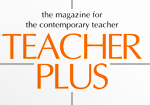Suhail Abdul Hameed
While thinking about writing an article on libraries, I went down memory lane and my own experiences of libraries. As a schoolboy, I was not a great reader but I always visited the school library and the reading room. My concern was not the bookshelves or the racks, it was always the second last pages (the sports pages) of different newspapers spread around the reading table. I used to be happy seeing my favorite football stars. Meeting Basheer (Vaikom Muhammed Basheer, a writer) in the Malayalam textbook of upper primary classes added one more objective to my library visits – finding his books and finishing reading it as soon as possible. Like this, everyone has their own experiences of engaging with a library as a space. In this article I will be reflecting upon our efforts to create such a space for the students in a government primary school in Chhattisgarh.
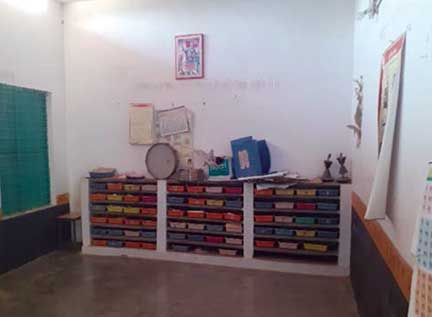
The title of the article may seem a little odd – ‘Rebirth of reading’. Yes, it is. But it connects to the core of what I am planning to write. During my visits to schools, I have seen different kinds of teaching learning materials (TLM) and books that are ignored, unattended or locked in an almirah inside or outside the staff room. These have been provided by government agencies, non-governmental organizations, or community members. The almost two year long school closure (even though opened in between) due to the pandemic has made things worse. Shelves used for reading corners have been replaced with dusty mats, old sacks of ration rice, utensils, garden tools or other things. Due to this, students have unfortunately been disconnected from books and the art of reading. Fortunately, they find few TLM’s for some self-initiated indoor games and leisure activities. Teachers consider a reading corner and the process of reading (beyond the textbooks) as something where they need to invest more time apart from the teaching-learning process. So, at least for the time being they are not concerned about the reading sessions or the reading corner. Similar situations are seen in schools which had an active reading culture or reading corner before the pandemic. I write this after visiting and observing five schools and their activities closely post COVID.
I decided to try my luck in Kamarpara Amali as a pilot project for ‘reading corner reorganization’ activity. There are a few reasons behind selecting PS Kamarpara Amali for this project.
- The teacher lives in the village itself. He is very supportive and welcoming towards new ideas and initiatives.
- No organization (including the Azim Premji Foundation) had any concrete intervention or field support here before.
- The number of students is less. The activity was designed only in my mind. I haven’t done this anywhere before. I didn’t know whether it will work. I had many concerns. Will it affect the learning? Will it help learning? Will the teacher be happy about it? Will the students enjoy it? So, it’s always better to go with a smaller number of students. This will also help in close observation and assessment of students.
- The learning levels of students here is not good. Out of 15 students only few can read and understand.
- The school is accessible for me from the Teacher Learning Centre (7 KM only). I can visit here at least once a week after completing a visit to any other school.
- I had visited the school several times during the lockdown and post COVID. We initiated activities like Bal mela, Bal akhbaar and mohalla classes. During the mohalla classes I used to take books to students and set up a mohalla library in the courtyard of the teacher’s house.
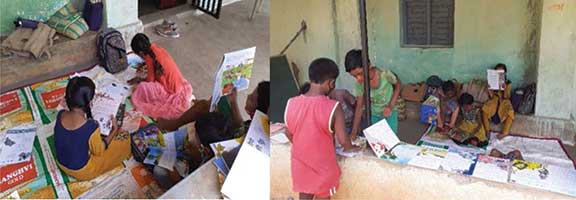
My objectives to initiate this activity are:
• To create an environment of free reading as part of the school process.
• To inspire students to read for fun.
• Making the students feel that they are part of the schooling process, rather than providing everything to them.
• To give the ownership of the reading corner and the books to the students themselves.
• To build an emotional connect with the students, books, and the act of reading.
Process
Day 1
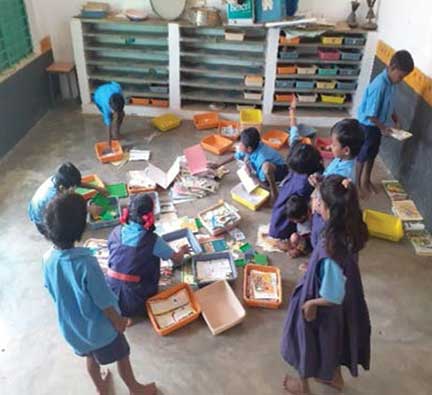
I had this idea of reading corner re-organization in my mind for several days. I spoke about this to the teacher a few times and he was excited as well.
It was a normal day in December. When I reached the school, the students and the teacher were sitting outside the school. After having an initial conversation with the teacher, I went inside the school and took out a few plastic trays in which torn pages, flash cards, book covers, plastic straws and other things were kept. I started sorting things based on different characters. After some time, Danesh of class 3 got bored of sitting outside and came inside. He saw me sitting in his classroom and sorting through stuff. He got interested in it and asked me whether he could join as well. I said, “It’s your school, your classroom, your TLMs, your books, your trays and your shelves.” He smiled and started taking out the trays and began sorting things. Three more students joined him.
Within an hour the whole school (15 students and 2 teachers) was inside the room. Students were having a wonderful time. This was a new experience for them. As all of them came in, I suggested that students of class 4 and 5 could sort the books. Other students sorted TLMs like flashcards, number cards, picture cards, letter cards and small plastic blocks used for counting. Temen of class 1 was running a delivery service for all. He carried trays full of books and TLMs to different parts of the class as per the request of others.
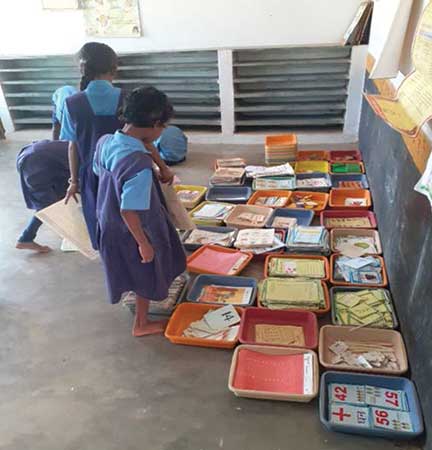
When it was time for the mid-day meal, we had sorted almost everything. Students went for lunch and I left for TLC. I had a word with the teacher that we could continue this activity another day. He was so happy that the students were actively engaging with books, letters, words and TLMs. And they were finding their own ways to solve issues. That’s what learning is all about.
Day 2
I had a three-day gap after the re-organization process. So, I planned a catalogue-making activity. Arun sir was absent and HM (Premlal Nag) was in his cabin. I explained the process to him as well as my plan for cataloguing. Arun sir had already briefed him and he had seen the result too. He was busy with documentation work and allowed me to continue the activity as per plan. Here I included students who could at least recognize the letters and could do basic reading and writing.
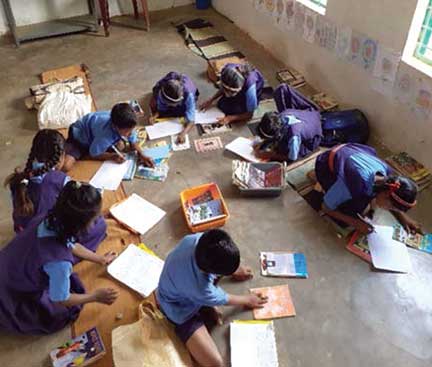
I assembled the students of class 4 and 5 in a classroom. Two students from class three also joined, as they wanted to. We sat in a circle. I took the trays that had the books and placed them in the center of our circle. I told them that we had to make a library catalogue. They had never heard of the word ‘catalogue’, neither did I know the hindi/chhattisgarhi name for the same. So I asked them to open their textbooks and see the index. The name of the chapter would be written with the serial number on the left and page number on the right. “In this way we will write the name of the book and the authors names of all the books that we have”. I made a demo of the column on the blackboard as well. A white A4 sheet was given to everyone and they were free to take the books they wanted.
It was a very interesting activity. The students had a lot of queries. Some books had just the title on the cover. The author’s name was not there. So I asked them to look at the first page. Most of them were confused as many things were written there. Name of the publisher, address of the publisher, date of publishing and many more. In some books (books with pictures) the name of the artist was also written. Students were confused with this as well. Here I intervened and helped them.
The books were sorted, catalogue made and more than all this, the students had read the title and authors names of atleast 10-15 books.
Day 3
I took the pages to TLC and got it bound. I used a thick black chart paper for the catalogue cover page.
This time I returned to the school after a day. The students’ task for the day was to design a cover page for the catalogue.
Digeswari of class 5 took up the responsibility for this task. In the meantime we arranged the books in the shelves, according to the level of readability. Books with more pictures and less text were placed at the bottom, books with equal text and pictures in the second shelf and so on.
Arun sir brought a new register to class and told them to enter the name of the student, date and book each time while taking a book home. He wrote the names of all the students in the register and showed them how to make an entry. But still the main part was missing all these days; reading. The one we wanted to give a rebirth.
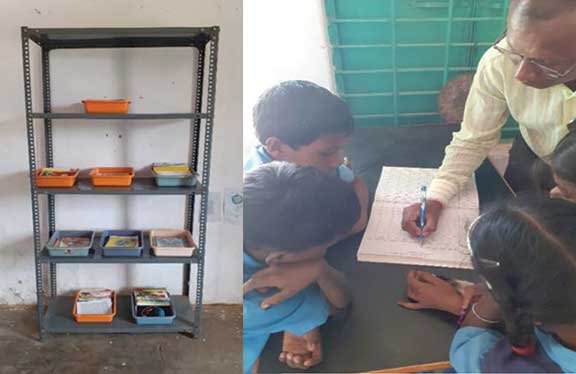
As we completed the organizing, cataloguing, binding, and registration, I requested the teacher and students for a reading session. Every student was given an opportunity to read. Most of them were decoding. They were struggling a lot to read, especially those students for whom the text was new.
The whole process was an action-based learning activity. It was continuous as well. We can view the process as a learning as well as assessment. For example, students were using their previous knowledge like pre-number concepts (comparison, sorting, classification) during the re-organization process. Students should be given ownership of their learning spaces and activities in every possible way. The teacher can act as a mentor and a companion.
After these sessions, I have been visiting the school at regular intervals. One thing that makes me happy is that the students are taking home at least one story book and the teacher too continues to hold reading sessions in the class.
The author is a resource person at Azim Premji Foundation, Chhattisgarh. His interests are in inclusive education and ethnography. He can be reached at suhail.hameed@azimpremjifoundation.org.
